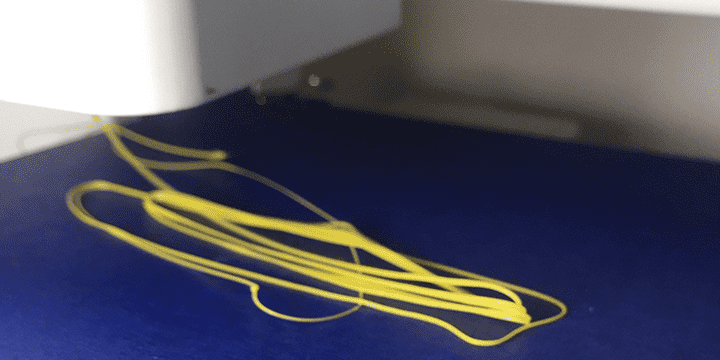Print quality troubleshooting guide
Improve the quality of your 3D-printed parts. A guide on how to fix the most common problems.
3D printer begins printing in mid-air
The print bed crashes into the print head at the start of the print resulting in a loud noise, and the print bed falls a bit down.
This happens because the print bed is too close to the print head causing it to crash into it. This will usually cause the print bed to lower a few centimeters, and thus the material will be extruded into the air instead of onto the build plate.
Bed calibration
Incorrect bed leveling can cause the 3D printer to print in mid-air.
The bed is leveled correctly when the distance between the nozzle and the bed is the same all over the entire bed regardless of the position of the nozzle. If the bed leveling is incorrect there are two possible outcomes:
- The printer will print in mid-air as the nozzle is too far from the print bed or
- The printer cannot extrude filament as the bed is too close to the nozzle, so there is not enough space for the material.
If this is the problem, it is very likely that the printer will already print in mid-air from the start or will not start to extrude in the beginning only after a few layers – as the Z-axis changes and the bed lowers accordingly.
Ensure the bed leveling method is set to automatically – if your printer supports it, or level your bed manually.
You can adjust the print bed (Z-axis) in REALvision Pro in the Printer settings/Bed leveling. Go through the bed calibration guide in the settings menu on the printer.
A software program to fit your needs
If you want to get quality prints without doing 3D modeling, consider adding REALvision Pro to your 3D printer kit. We promise you easy-to-use 3D slicing software in the high-end printing industry. Suppose you are:
- A picky hobbyist with a cheap desktop 3D printer.
- Running a 3D printing service with flawless 3D prints.
- 3D printing metal parts for aerospace.
- 3D printing customizable prosthetics, implants, or casts in ABS plastic (Acrylonitrile Butadiene Styrene).
- Rapid prototyping 3D models from design software.
- Need help with calibration or material profiles.
- Finding the best 3D printer for your application.
- Exploring manufacturing processes and technology to obtain zero-waste.
In that case, we have a software plan fitting your needs.
Did you know?
FDM printing comes from the abbreviation Fused Deposition Modeling and it is also known as Fused Filament Deposition (FFD) technology, and as Fused Filament Fabrication (FFF). The spool of filament is the material used to build the 3D part by melting the plastic out of the nozzle of the 3D printer. All 3D printing filament starts out in pellet form – small granules of plastic. The filaments can be made of different types of plastic. The most commonly used plastics are PLA which is Polylactic Acid and ABS which stands for Acrylonitrile Butadiene Styrene. Both materials have favorable mechanical properties, ABS is well known for its impact resistance, toughness, and rigidity, and is also commonly used in injection molding besides additive manufacturing. PLA is known for its low melting point, high strength, low thermal expansion, good layer adhesion, and high heat resistance. It has also become a popular material due to it being economically produced from renewable resources (bioplastics).
The printer extrudes this filament line by line, layer by layer, by increasing the z-axis, and will build the 3D printed part.
